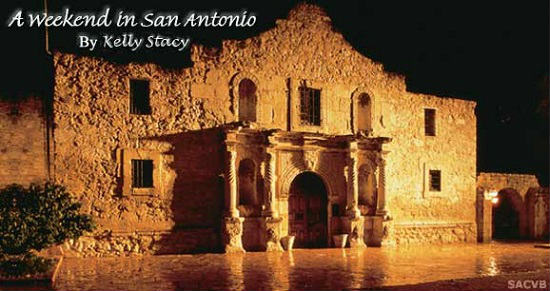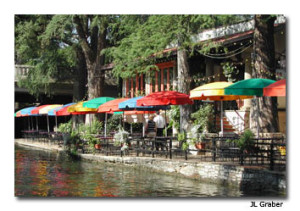

It’s not just for cowboys anymore. San Antonio has traded in its spurs and chaps for a tight pair of jeans and stylish shoes. Don’t think San Antonio has changed too much, though — it still wears its customary cowboy hat.
But what was once the site of the revolution against Mexico is now a bustling metropolis full of history, art and culture. Every old and new cowboy is bound to find something that ropes him in. No less than six different flags have flown over San Antonio — French, Spanish, Mexican, Republic of Texas, Confederate and the Stars and Stripes. And while this is certainly a true American city, San Antonio still clings to its deep Spanish roots.
It’s a city exploding with rich history. Built around the Alamo, the site of the famous standoff between Texan revolutionaries and Mexican soldiers, San Antonio has preserved and cherished its dynamic history and has put out a welcome mat for visitors and natives to explore openly. Many cultures reside side-by-side in San Antonio, including Native Americans, Old Mexico, German immigrants, the Wild West, African-Americans and the Deep South, making this cosmopolitan city fresh with heritage and diversity.
Every turn brings new variety. Explore El Mercado, an authentic Mexican market, or take a riverboat cruise along the River Walk, San Antonio’s most famous attraction. Stroll through King William Historic District or marvel at the mission houses on the historic San Antonio Mission Trail. Whatever you do, there’s plenty of action, history and entertainment to be had in this distinct pocket of the world.
Friday
Four routes drop passengers off at major attractions, including the Alamo, the Spanish Governor’s Palace, La Villita, Sunset Station, the Southwest School of Art and Craft, the Institute of Texan Cultures, the King William Historic District and downtown shopping area. (More on each of these attractions later.) A new route has been added to accommodate tourists to several more cultural and entertaining destinations (Information center found at 260 E. Houston; 210-362-2020).San Antonio is the eighth largest city in the United States, so renting a car could be useful.
For most of your transportation needs though, VIA Streetcar is the way to go. Designed after authentic streetcars, this open-aired reproduction has traveled the streets of San Antonio for more than 50 years. Your first stop might be the Alamo Street Victorian Inn (951 S. Alamo St.; 210-212-5533; www.kwilliam.com).
Newly renovated, this 1896 landmark is tastefully decorated with second floor verandas, and has private baths with marble showers and whirlpool tubs. This quant bed and breakfast is conveniently located on the Trolley route just 15 minutes from downtown, and the River Walk, the Alamo and Convention Center are within walking distance.
If you’d rather stay at a hotel on the River Walk, try the elegant La Mansión del Rio (112 College Street; 800-292-7300; www.lamansion.com). With a rich history dating back to 1852, this beautifully restored hotel is an historic landmark. It’s conveniently located near downtown restaurants and many hot spots along River Walk. Take the VIA Streetcar to San Antonio’s most celebrated historical site, the Alamo (300 Alamo Plaza; 210-225-1391; www.thealamo.org).
Although originally built as a mission across the river from the tiny town of San Antonio, the city now surrounds the Alamo. This famous spot is where 189 defenders of Texas Independence from Mexico fought some 4,000 Mexican troops for 13 days.
Although the Mexican army won, many Texans believe this historical battle brought Texas its ultimate independence. The Alamo is the heart of the thriving city and is revered by locals as a sacred shrine. One hotel was denied its building plans when it was discovered its shadow might fall across the Alamo at certain times of day. The chapel, one of the most photographed facades in the nation, and the Long Barracks are all that remain of the original fort, making the Alamo much smaller than expected.
Monday through Saturday the Alamo is open from 9 a.m.-5:30 p.m. and 10 a.m.-5:30 p.m. on Sundays. Admission is free but donations are gladly accepted. To experience more of the historic mission houses in San Antonio, take the San Antonio Mission Trail along the San Antonio River.
Four mission houses reside here including Missions San José, San Juan, Espada and Concepción. Open year-round from 9:00 a.m.-5:00 p.m., this National Historic Park contains a number of cultural sites and natural resource areas. Mission San José (6701 San Jose Dr.; 210-932-1001) is the largest and best-known of the mission houses. The church is most notable for its carvings and is famous for the Rose Window, considered one of the finest pieces of Spanish colonial ornamentation in the country.

Enter through the historic Sunset Saloon and take pictures with the 1916 Steam Engine 794. Stay for dinner at Aldaco’s (100 Hoefgen; 210-222- 0561; www.aldacos.net) and enjoy an MPO (Margarita Pour Off Queen) under the stars as the smooth sounds of Latin jazz fill the crisp night air.Last stop of the day is Sunset Station, (1174 E. Commerce; 210-222- 9481; www.sunsent-station.com), the building of 1,000 lights. Built in 1902, this station is famous for Sunset Limited, a train stop connecting San Francisco to New Orleans and San Antonio.
Saturday
Begin the day at El Mercado, or Market Square (514 W. Commerce; 210-207- 8600; www.tavernini.com), the largest Mexican marketplace outside of Mexico. Open 10 a.m. -8 p.m. with free admission, Market Square boasts 32 shops built after the original design of Mexican marketplaces.
Bargain shop for authentic crafts, clothes and food in multicolored shops and booths. Dance to the music of the mariachi bands and watch the colorful folklore dancers swirl to the beat. Later, browse through 80 specialty shops in the Farmers Market Plaza.
Stop for lunch at Mi Tierra Café & Bakery for tempting fajitas or mouth-watering steak and enchiladas served with Spanish rice and refried beans (www.mitierracafe.com). Mi Tierra’s bakery tempts you with sweets, including sugar-coated cuernos (the Mexican croissant), snappy semitas (flat bread dusted with cinnamon, sugar and nuts) or delicate palmitas (a flaky, sugary pastry).
After shopping, tuck your bags away and get ready for a relaxing cruise on the San Antonio River. River Walk, or Paseo del Rio (www.thesanantonioriverwalk.com), is in the heart of the city and one of the largest tourist attractions in San Antonio.
Cobblestone walkways follow the peaceful river meandering down to the river-level restaurants and shops. Delight in a 35-minute narrated boat ride of the San Antonio River or experience a Mud Festival firsthand (Rio San Antonio Cruises; 800-417-4139 or 210-244-5700; www.sarivercruise.com). Enjoy a stroll through three miles of lush vegetation and towering trees.
Flag down a river taxi and take a ride to the Rivercenter, a three-level glass shopping complex filled with restaurants, shops and nightclubs.
Time for dinner? How ‘bout some real Texas barbeque? Try County Line Restaurant located on the River Walk (W. Crocket St.; 210-229-1941; www.countyline.com). Featuring an open-air bar, don’t forget to check out the inside decor with a funky Texas roadhouse atmosphere.
Coining the phrase “Get it all over ya’!” these people mean business. Home-style cookin’ Texas’ way, enjoy barbecue ribs with sliced franks, coleslaw, beans and bread. Don’t forget to order a frosty mug of beer or slushy margarita.
No trip to San Antonio would be complete without a jaunt through the King William Historic District. Found near the south bank of the San Antonio River, the district is 25 blocks of the most elegant residential buildings in the city. Established by German immigrants in the 1840’s, the main entry street was named after Kaiser Wilhelm I, King of Prussia, in the 1870’s.
After World War I, the name was changed but then changed back to the English name King William. Many literary figures have been associated with the area, including Sydney Lanier, Josephina Niggli, Naomi Shihab Nye and Sandra Cisneros.
Sunday At the end of King William Historic District is the Guenther House (205 E. Guenther; 210-227-1061 or 800-235-8186; www.guentherhouse.com). The founder of Pioneer Flour Mills, Carl Hilmar Guenther built the European-style home in 1860.
It’s the country’s oldest-working flour mill and features a museum with mill memorabilia and an outstanding restaurant. Eat the Champagne chicken enchiladas and gorge on real German pastries made with San Antonio River Mill mixes while unwinding outside under the terraced patio overlooking the San Antonio River.
The next district is La Villita, affectionately called Art in the Heart of San Antonio (418 Villita; 210-207-8610; www.lavillita.com). San Antonio’s first neighborhood, La Villita was originally a settlement of huts for Spanish soldiers. After a flood in 1819, adobe houses replaced the primitive huts.
Today this restored district is paved with cobblestone walkways and is home to a unique arts and crafts community. Filled with shops, museums, working artists and restaurants, the historic district is the new thriving art scene. Shops open 10:00 a.m.-6:00 p.m. daily with no admission.
Is the weekend really over? There’s not enough time to catch everything San Antonio has to offer. Check out www.sanantoniovisit.com for your next visit to the Lone Star State, and don’t forget the kids this time.
- What It’s Like to Live as an Expat: Lake Chapala, Mexico - April 18, 2024
- Top 5 Spots for Stargazing in North Carolina - April 17, 2024
- The Low-Key Magic of Ghent, Belgium - April 17, 2024
